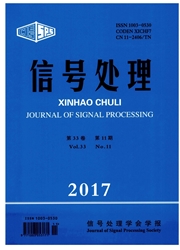

 中文摘要:
中文摘要:
旋翼目标是机载毫米波脉冲多普勒雷达低空与地面目标中的首要识别对象,由于其回波频谱展宽与波长成近似反比关系,使其在毫米波段呈现低信杂比、弱特征现象。本文首先在分析毫米波雷达旋翼目标特性的基础上,针对旋翼识别难题,对雷达系统前端的波束驻留时间、脉冲重复周期、杂波抑制性能、相参积累脉冲数、频综器相位噪声谱密度等参数设计提出了新的要求;之后,设计了专用目标识别软件平台,并给出了面向工程应用的专用目标识别软件总体结构,提出了利用噪声归一化的频谱数据预处理技术、识别结果积累策略以及多普勒频谱层析图分析等信号处理方法;最后,利用实测数据提取特定的特征对目标进行识别分类,并对部分中间结果进行了详细分析,实验结果验证了本文方法的有效性,对旋翼和固定翼目标具有良好的分类识别性能。
 英文摘要:
英文摘要:
Among the low attitude and ground targets, rotorcrafts are the most important to be recognized in the airplanecarried millimeter wave pulse Doppler radar. Rotorcraft targets suffer from low signal to clutter rate and weak characters at millimeter waveband because the width of modulated spectrum of its radar echoes is inversely proportional to the signal wave- length. This paper first analyzes the feature of rotorcrafts in the millimeter-wave radar. And aiming at the involved rotorcraft recognition we propose some new requirements for parameters of the radar system, such as the beam dwell, pulse repeat in- terval, performance of clutter suppression, number of coherent integration pulses and phase noise spectrum density of the frequency synthesizer. Then, the specific target recognition platform is designed and the main structure of the software orien- ted at engineering application is given. Some key signal processing technologies are proposed such as spectrum pretreatment technology with noise normalization, accumulating strategy of recognition results and the ripple slice mapping of Doppler spectrum etc. Finally, the experimental data are used for feature extracting and target recognizing, and some medium results are discussed in detail. The experiment results demonstrate that the theoretical analyses in this paper are efficient and the proposed methods perform well in recognition of rotorcraft and fixed-wing aircraft targets.
 同期刊论文项目
同期刊论文项目
 同项目期刊论文
同项目期刊论文
 Performance bounds of direction finding and its applications for multiple-input multiple-output rada
Performance bounds of direction finding and its applications for multiple-input multiple-output rada Weighted average frequency algorithm for Hilbert-Huang spectrum and its application to micro-Doppler
Weighted average frequency algorithm for Hilbert-Huang spectrum and its application to micro-Doppler High-speed Target ISAR Imaging via Compressed Sensing Based on Sparsity in Fractional Fourier Domain
High-speed Target ISAR Imaging via Compressed Sensing Based on Sparsity in Fractional Fourier Domain Manifold studies on fundamental limits of direction-finding multiple-input multiple-output radar sys
Manifold studies on fundamental limits of direction-finding multiple-input multiple-output radar sys Dynamic Compressed HRRP Generation for Random Stepped-Frequency Radar Based on Complex-Valued Fast S
Dynamic Compressed HRRP Generation for Random Stepped-Frequency Radar Based on Complex-Valued Fast S ISAR imaging of multiple targets using particle swarm optimisation - adaptive joint time frequency a
ISAR imaging of multiple targets using particle swarm optimisation - adaptive joint time frequency a Random finite sets-based joint manoeuvring target detection and tracking filter and its implementati
Random finite sets-based joint manoeuvring target detection and tracking filter and its implementati Effects of transmitting correlated waveforms for co-located multi-input multi-output radar with targ
Effects of transmitting correlated waveforms for co-located multi-input multi-output radar with targ Sparsity-aware space-time adaptive processing algorithms with L-1-norm regularisation for airborne r
Sparsity-aware space-time adaptive processing algorithms with L-1-norm regularisation for airborne r Sparsity-based space-time adaptive processing using complex-valued Homotopy technique for airborne r
Sparsity-based space-time adaptive processing using complex-valued Homotopy technique for airborne r Effects on beam pattern performance for colocated multi-input multi-output radar transmitting correl
Effects on beam pattern performance for colocated multi-input multi-output radar transmitting correl A Compact Methodology to Understand, Evaluate, and Predict the Performance of Automatic Target Recog
A Compact Methodology to Understand, Evaluate, and Predict the Performance of Automatic Target Recog Power allocation for range-only localisation in distributed multiple-input multiple-output radar net
Power allocation for range-only localisation in distributed multiple-input multiple-output radar net L-1-Regularized STAP Algorithms With a Generalized Sidelobe Canceler Architecture for Airborne Radar
L-1-Regularized STAP Algorithms With a Generalized Sidelobe Canceler Architecture for Airborne Radar Rotating parabolic-reflector antenna target in SAR data: Model, characteristics, and parameter estim
Rotating parabolic-reflector antenna target in SAR data: Model, characteristics, and parameter estim Wideband electromagnetic characteristics modeling and analysis of missile targets in ballistic midco
Wideband electromagnetic characteristics modeling and analysis of missile targets in ballistic midco Target classification of ISAR images based on feature space optimisation of local non-negative matri
Target classification of ISAR images based on feature space optimisation of local non-negative matri Pulse-repetition-interval transform-based vibrating target detection and estimation in synthetic ape
Pulse-repetition-interval transform-based vibrating target detection and estimation in synthetic ape 期刊信息
期刊信息
